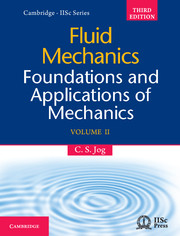Refine search
Actions for selected content:
5487 results in Thermal-fluids engineering
14 - Thermodynamic Considerations
-
- Book:
- Fluid Dynamics
- Published online:
- 28 May 2018
- Print publication:
- 05 May 2015, pp 131-139
-
- Chapter
- Export citation
Index
-
- Book:
- Fluid Dynamics
- Published online:
- 28 May 2018
- Print publication:
- 05 May 2015, pp 249-252
-
- Chapter
- Export citation
19 - Applications to Viscous Flow
-
- Book:
- Fluid Dynamics
- Published online:
- 28 May 2018
- Print publication:
- 05 May 2015, pp 188-210
-
- Chapter
- Export citation
11 - Stress Tensor: Existence and Symmetry
-
- Book:
- Fluid Dynamics
- Published online:
- 28 May 2018
- Print publication:
- 05 May 2015, pp 110-115
-
- Chapter
- Export citation
References
-
- Book:
- Fluid Dynamics
- Published online:
- 28 May 2018
- Print publication:
- 05 May 2015, pp 247-248
-
- Chapter
- Export citation
9 - Fluids at Rest
-
- Book:
- Fluid Dynamics
- Published online:
- 28 May 2018
- Print publication:
- 05 May 2015, pp 91-103
-
- Chapter
- Export citation
13 - Navier-Stokes Equation
-
- Book:
- Fluid Dynamics
- Published online:
- 28 May 2018
- Print publication:
- 05 May 2015, pp 126-130
-
- Chapter
- Export citation
17 - Applications of Bernoulli's Equation and Control Volumes
-
- Book:
- Fluid Dynamics
- Published online:
- 28 May 2018
- Print publication:
- 05 May 2015, pp 160-172
-
- Chapter
- Export citation
8 - Accelerating Reference Frames
-
- Book:
- Fluid Dynamics
- Published online:
- 28 May 2018
- Print publication:
- 05 May 2015, pp 82-90
-
- Chapter
- Export citation
APPENDIX B - Tensors
-
- Book:
- Fluid Dynamics
- Published online:
- 28 May 2018
- Print publication:
- 05 May 2015, pp 242-246
-
- Chapter
- Export citation
Contents
-
- Book:
- Fluid Dynamics
- Published online:
- 28 May 2018
- Print publication:
- 05 May 2015, pp vii-x
-
- Chapter
- Export citation

Fluid Mechanics
- Foundations and Applications of Mechanics
-
- Published online:
- 05 May 2015
- Print publication:
- 25 June 2015
16 - Complete Equations of Motion
-
- Book:
- Fluid Dynamics
- Published online:
- 28 May 2018
- Print publication:
- 05 May 2015, pp 147-159
-
- Chapter
- Export citation
APPENDIX A - Equations in Curvilinear Coordinates
-
- Book:
- Fluid Dynamics
- Published online:
- 28 May 2018
- Print publication:
- 05 May 2015, pp 239-241
-
- Chapter
- Export citation
7 - Geometry and Grids
-
- Book:
- Applied Computational Aerodynamics
- Published online:
- 28 May 2018
- Print publication:
- 27 April 2015, pp 448-538
-
- Chapter
- Export citation
Appendix C - Potential Flow Review
-
- Book:
- Applied Computational Aerodynamics
- Published online:
- 28 May 2018
- Print publication:
- 27 April 2015, pp 776-789
-
- Chapter
- Export citation
Nomenclature
-
- Book:
- Applied Computational Aerodynamics
- Published online:
- 28 May 2018
- Print publication:
- 27 April 2015, pp xxvii-xxx
-
- Chapter
- Export citation
Index
-
- Book:
- Applied Computational Aerodynamics
- Published online:
- 28 May 2018
- Print publication:
- 27 April 2015, pp 833-849
-
- Chapter
- Export citation
6 - Introduction to Computational Fluid Dynamics
-
- Book:
- Applied Computational Aerodynamics
- Published online:
- 28 May 2018
- Print publication:
- 27 April 2015, pp 350-447
-
- Chapter
- Export citation
Plate section
-
- Book:
- Applied Computational Aerodynamics
- Published online:
- 28 May 2018
- Print publication:
- 27 April 2015, pp -
-
- Chapter
- Export citation
